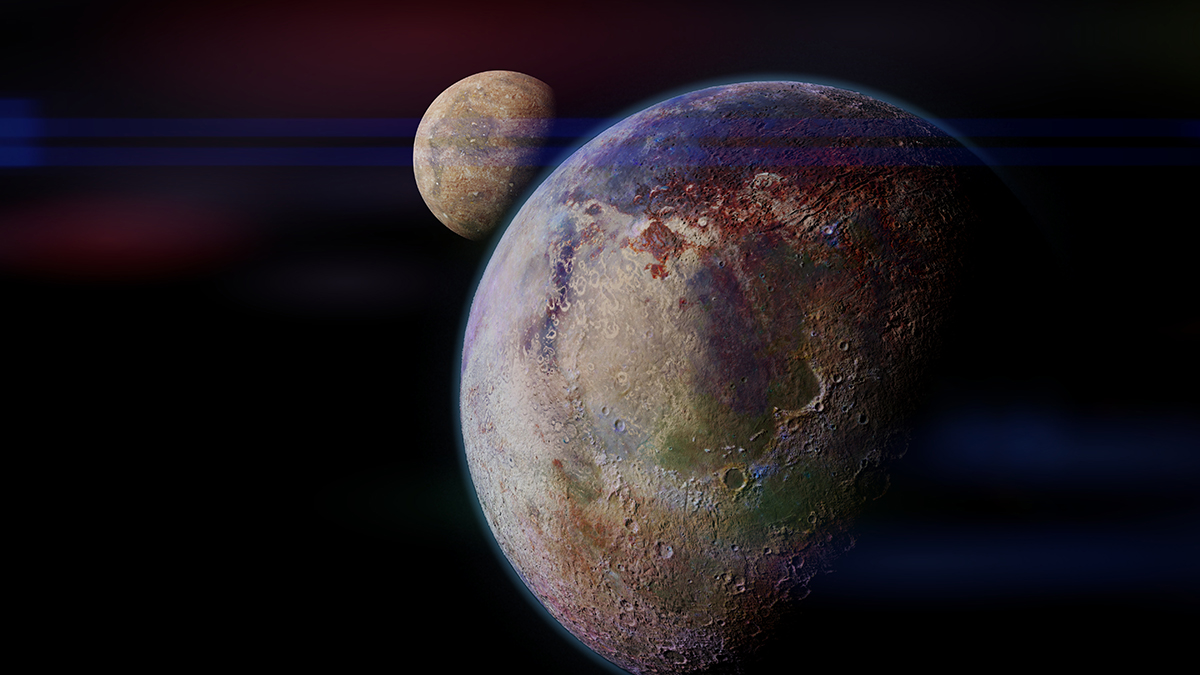In a contest of which planet in the solar system has the most relatively massive moon, Earth takes the prize. The Moon is roughly 1% of Earth’s mass, whereas the moons of all the remaining moon-bearing planets—that’s all of them save for Mercury and Venus—are less than one ten thousandth their planets’ masses. (Pluto’s moon Charon is 12% its mass, but Pluto, alas, is not a planet.)
“We think that a giant impact is a very efficient way to form fractionally large moons,” said Miki Nakajima, a planetary scientist at the University of Rochester in New York. Large collisions are thought to be a common occurrence in the chaos of a still-forming solar system, but if all giant impacts formed fractionally large moons, our solar system would be rife with them.
What happens when rocky or icy would-be planets of various sizes collide?
So why is the Moon (alright, and Charon, too) so fractionally large? Answering this question would help planetary scientists better understand early Earth-Moon history and also narrow the search for large moons around extrasolar planets.
Using computer simulations, Nakajima and her colleagues explored what happens when rocky or icy would-be planets of various sizes collide. The researchers found that after such a major impact, only rocky planets less than 6 times Earth’s mass and icy planets less than 1 Earth mass can form a fractionally large moon out of the collision debris. They published these results in Nature Communications on 1 February.
Rocky Versus Rocky, Icy Versus Icy
The diversity of moons in our solar system results from the diversity of ways those moons formed. Some satellites (like Jupiter’s Galilean moons and Saturn’s Titan) coalesced in situ out of a disk of material left over from when their host planet formed. Many other moons, including Mars’s Phobos and Deimos and Neptune’s Triton, formed somewhere else in the solar system and were gravitationally captured by their planets. To our knowledge, only the Moon and Charon formed out of impact debris when two young protoplanets collided. Many of the particulars about the Moon-forming impact, like the size, speed, and composition of the impactor, are still under active debate in the scientific community, but most scientists agree that there was, indeed, an impact.
But what if the Earth or the impactor had been more massive? What if, instead of silicates and iron, the planet or impactor was mostly made of ice? Could such a planet have survived the impact and still have formed such a fractionally large moon? Planet hunters have discovered dozens of exoplanets that are similar to but not quite exactly like Earth, and knowing which of those planets are more likely to form large, detectable exomoons will help astronomers find them.
Nakajima and her colleagues simulated the collisions of two rocky protoplanets with iron cores and forsterite mantles and also of two icy protoplanets with forsterite cores and water ice mantles. In the simulations, the two protoplanets sideswipe each other, break apart into tiny molten particles and gaseous vapor, and reform into something new. They didn’t test the collision of a rocky protoplanet with an icy one because that would be a far less likely scenario, Nakajima explained. By varying the masses of the two protoplanets that collide, the researchers could determine how large a planet has to be to form a fractionally large moon from the impact debris, as well as what physics determines the collision outcome.
The simulations revealed that rocky planets heavier than 6 times Earth’s mass, equivalent to about 1.6 times the size of Earth, are unable to form a fractionally large moon out of the collision debris (but could still form much smaller moons). Icy planets heavier than 1 Earth mass or larger than about 1.3 Earth radii are equally unable to create large moons. Below those mass thresholds, the planets were able to create a moon at least a few percent of the planet’s mass.
The limiting factor for creating large moons turned out to be how much vapor, either silicate vapor or water vapor, was in the collision debris. “If the moon-forming disk is completely vapor, it cannot be a place for growing moons,” Nakajima said. In the debris of more massive planets, the higher quantity of vapor quickly drags the collision debris back onto the planet before it can coalesce into a moon, like flotsam swept away by a raging sea. For lower-mass planets, the lower vapor content allows different materials to gravitate toward each other and eventually form a large moon.
Where to Find Exomoons
First and foremost, these simulations are consistent with the moons that we see in our solar system and agree with the canonical Moon formation scenario: A rocky Mars-sized protoplanet collided with a rocky Earth-sized protoplanet in a grazing impact. Beyond that, these simulations will help astronomers narrow their search for the moons of exoplanets, none of which have yet been confirmed.
“If this is true, I guess maybe it makes my job a bit harder!”
“It’s a cool result,” said Alex Teachey, an astronomer and exomoon hunter at Academia Sinica Institute of Astronomy and Astrophysics in Taipei, Taiwan. Teachey was not involved with this research. “It makes a lot of sense to me, and it’s always great to see papers that are making predictions about the exomoon population, not just explaining what we see in our solar system.…But of course we lack any of these planets intermediate in mass between Earth and Neptune, so we really do need the exomoon search to test this prediction.”
“If this is true, I guess maybe it makes my job a bit harder!” Teachey said. “As the community zeroes in on planets that are more and more Earth-like or Earth-sized, necessitating larger telescope apertures, hopefully, we’ll be getting a lot of data in which we might be able to spot the moons as well.”
—Kimberly M. S. Cartier (@AstroKimCartier), Staff Writer



